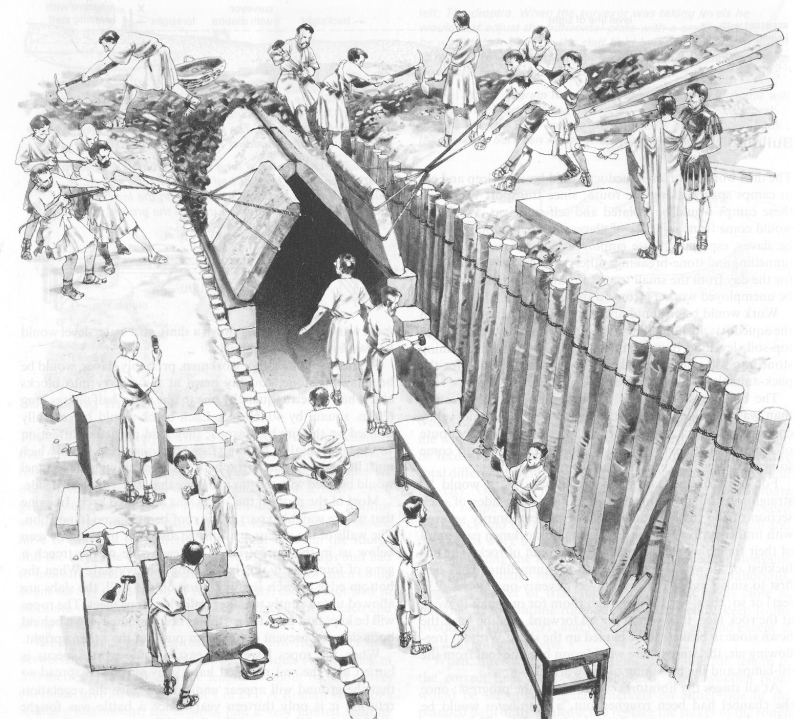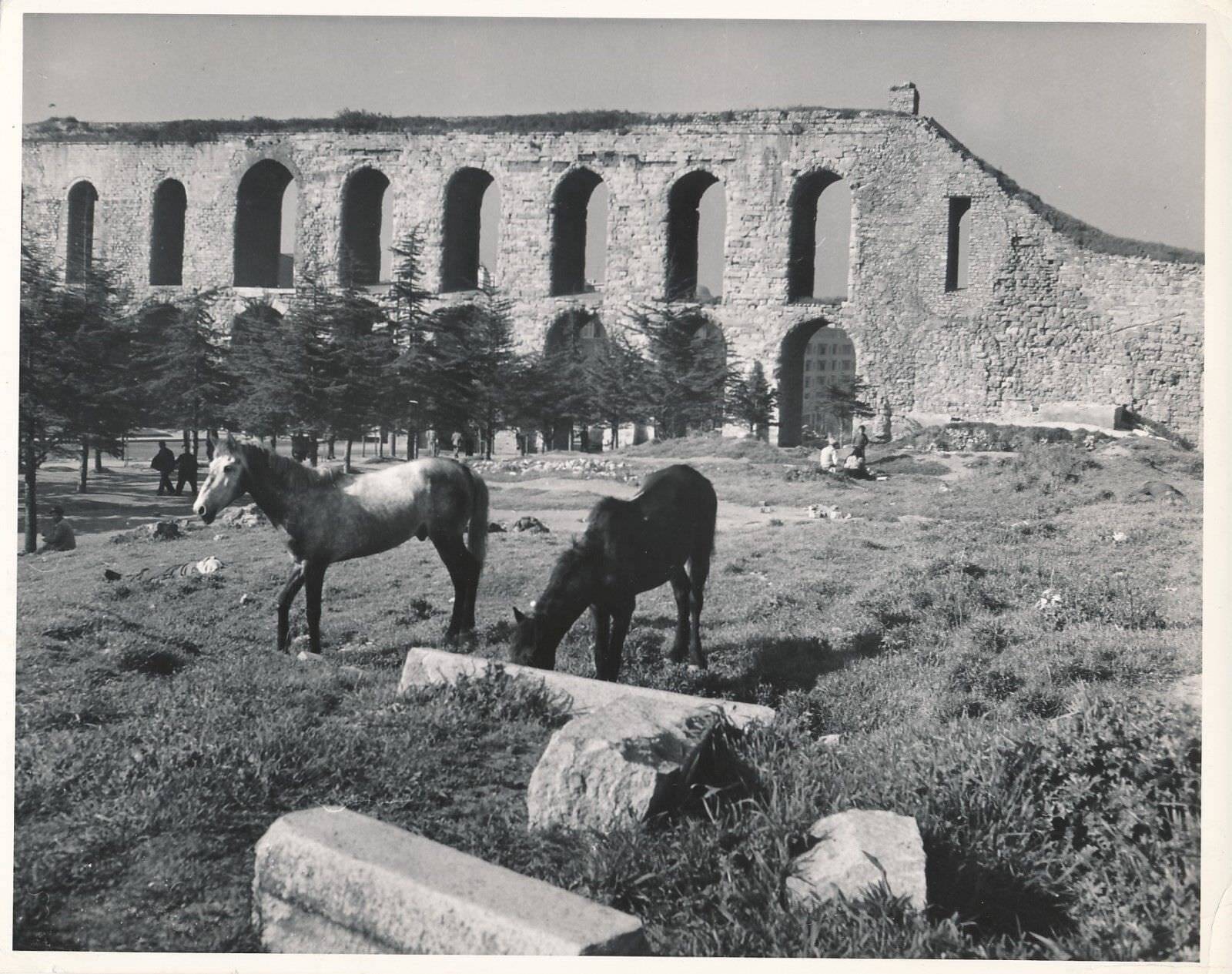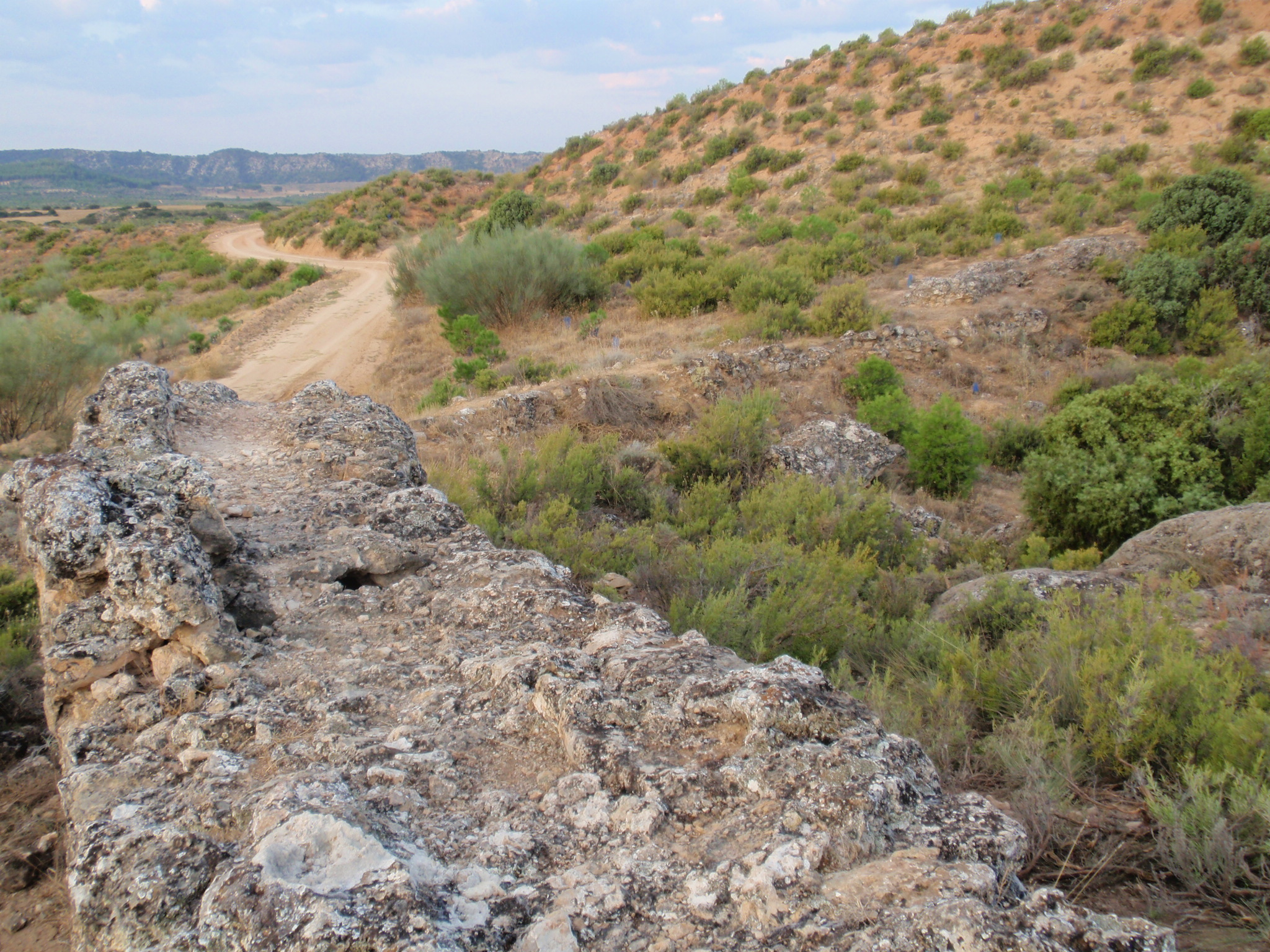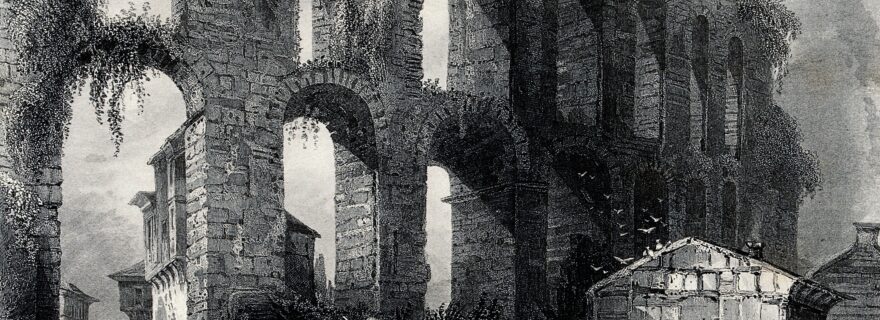Aqueduct warfare: Water infrastructure and sieges in post-Roman Europe
Aqueducts were impressive feats of Roman engineering which supplied cities with fresh water. In the early middle ages, however, they also posed a ‘security risk’ in siege warfare.
Many Roman cities relied on aqueducts in order to supply their citizens, bath houses, latrines and fountains with fresh water. Enabling the comforts of Roman urbanism, aqueducts were not only marvels of engineering but also effective means of imperial propaganda. Roman aqueducts consisted of conduits running tens or even hundreds of kilometres long underground, but are iconic nowadays for their stone bridges that transported water across valleys and into cities.

Reconstruction drawing of a subterranean channel constructed by the Romans. Source: RomanAqueducts.info
Despite the advantages they might bring, written sources show that in the early middle ages, aqueducts may have been more trouble than they were worth. In this blog I will discuss a couple of evocative anecdotes which suggest aqueducts made cities more vulnerable in times of war.
An indignant engineer
The first anecdote comes from sixth-century Gaul. The brothers Gundobad and Gundegisel both inherited part of the kingdom of Burgundy after their father Gundioc died in 473. The divided inheritance was a source of animosity between both brothers, and around the turn of the century Gundobad gathered his army and marched against his brother, besieging him inside the city of Vienne.
The besieged Godegisel began to run out of food as time passed. To avoid starvation, he commanded the common people to leave the city. Among the expelled citizens was an engineer in charge of the city’s aqueduct, who then approached Gundobad and revealed to the rival king how to break into the city:
“With this engineer to show them the way, Gundobad’s army was led along the aqueduct. At the head marched a number of sappers with iron crowbars. There was a water-gate blocked by a great stone. Under the direction of the engineer they heaved this stone on one side with their crowbars, made their way into the city and attacked from the rear the defenders, who were still busy shooting their arrows from the wall”.
(Gregory of Tours, Histories, 2.33, transl. Thorpe.)
The story is fascinating, because it shows us that Vienne’s aqueduct was still in use and the technical knowledge to keep it running was not lost. However, the aqueduct also allowed the besiegers to bypass the city walls and ambush the unknowing defenders. Godegisel was caught by surprise and killed; the victorious Gundobad became the sole ruler of Burgundy.
Secret tunnel
Interestingly, a very similar tactic was used in another sixth-century conflict. In 536, general Belisarius invaded the Ostrogothic kingdom of Italy at the behest of the emperor Justinian. His advance was halted at the fortified city of Naples, and so a siege ensued. Belisarius cut off the city’s aqueduct, in order to deprive the city of its water supply. This was to little avail, as the Neapolitans had enough water stored in wells to quench their thirst. After a few weeks, Belisarius was on the verge of despair and ready to abandon the siege, when one of his soldiers discovered a hidden entrance into the city:
“He entered it [the aqueduct] at a place far distant from the city, where Belisarius had broken it open, and proceeded to walk along it, finding no difficulty, since the water had stopped running because the aqueduct had been broken open.”
(Procopius, History of the Wars, 5.9.12-13, transl. H.B. Dewing)
Near the walls, the soldier discovered a tunnel leading through rock, right into the city. The gap was too small for an armoured soldier to pass through, but Belisarius sent men to widen the passage with iron files:
“[…] Coming to the place where the rock caused the passage to be narrow, they began their work, not cutting the rock with picks or mattocks, lest by their blows they should reveal to the enemy what they were doing, but scraping it very persistently with sharp instruments of iron. And in a short time the work was done, so that a man wearing a corselet and carrying a shield was able to go through at that point.”
(Procopius, History of the Wars, 5.9.20-21, transl. H.B. Dewing)
Then, under the cover of night, six hundred soldiers crept through the tunnel into the city, ambushing the defenders on the walls and allowing the rest of Belisarius’ army to enter the city.
Belisarius did not forget what he had learned at Naples. The next year, when Belisarius was himself besieged by the Goths inside the city of Rome, he had the aqueducts’ access points blocked with masonry. Still the enemy soldiers looked for a way in, exploring the Aqua Virgo. Fortunately for Belisarius, the light of their torches revealed the Gothic soldiers and they were repelled.

Artist's impression of general Belisarius and his army outside the Aurelian Walls of Rome. Source: DeviantArt.
Sneaking past the defenders on the city walls through the aqueduct seems to have been a common tactic in the early middle ages. Indeed, the same tactic was used again two centuries later in 705 by the Byzantine emperor Justinian II, who snuck through the defunct Aqueduct of Valens into Constantinople and so defeated his rival Tiberius III (Theophanes, Chronographia, AD 704/5).
Cutting the water supply
Another common tactic was to cut off the aqueduct’s water supply. Sometimes, as in Naples, this caused few (immediate) problems. At other times, the potential ramifications could be more severe. When the Goths laid siege to Belisarius inside Rome (537-538) they cut off the supply from the Campanian aqueducts. This did not threaten the Romans’ supply of drinking water, but it did stop the flow of water needed to power the grain mills. Belisarius devised a clever solution and placed floating watermills on the river Tiber to keep the bread supply going. While crisis was averted this time, it shows just how fragile a city could be in war time if it relied on aqueducts for its survival.
Similarly, during the Avar siege of Constantinople in 626, the besiegers cut off the Aqueduct of Valens. While the Avars failed to capture the imperial capital, the damage was more permanent. Repair seems to have been prohibitively expensive; the aqueduct stayed out of use for more than a century. Only when the city suffered extreme draught in 767 and its cisterns, baths and springs had run dry, did the Byzantine emperor finally devote resources to restoring the ancient aqueduct. The repairs, one source tells us, required an immense labour force consisting of 200 plasterers, the same amount of brickmakers, 500 clay-workers, 1000 masons and 5000 labourers, who had to be recruited from the far-flung provinces of the empire (Theophanes, Chronographia, AD 765/6). If these numbers are accurate, then we can get an idea of just how expensive aqueduct maintenance could be.

Aqueduct of Valens, Istanbul (1940). Source: https://www.thebyzantinelegacy.com/valens-aqueduct.
The last aqueduct
Over time, many towns stopped maintaining their aqueducts altogether. A study by archaeologist Javier Martinez Jiménez for early medieval Spain found that only a handful of aqueducts remained in operation by the seventh century. The situation is similar across the post-Roman world.
Were aqueducts abandoned because of their tactical disadvantage? There is no easy answer to that question. Other factors certainly played a role too. As urban populations shrank and the nature of cities changed, the aqueduct probably became too expensive to maintain for too little gain.
Still, we must remember that not all was doom and gloom. When we look past the incidental violence, we learn from these anecdotes that many early medieval towns did, in fact, still have working aqueducts and the technical expertise to keep them running. Archaeological and textual evidence both show that the popes in Rome kept some of the aqueducts in working order into the tenth century, so as to supply the many baptisteries, bath houses and water mills of the city. Likewise, after the eighth-century repairs, the Aqueduct of Valens in Constantinople was operational well into the twelfth century.
There is even one instance of a new aqueduct being built. In 578, king Leovigild of Visigothic Spain founded a new royal city, named Reccopolis after his son Reccared. Like other royal seats of the time, it was modelled after the imperial city of Constantinople. It therefore needed the architectural ‘package’ of the ideal late antique city: a palace, main street, city walls and, indeed, an aqueduct.

Remains of the aqueduct at Reccopolis, built late in the sixth century. Source: Wikicommons.
Aqueducts may have lost their importance for ordinary towns. Yet, kings, emperors and popes continued to embellish the most important cities with water infrastructure in order to impress subjects and visitors alike. Besides their practical use, aqueducts were effective tools of propaganda, creating a link with the Roman past to legitimise their own rule.
Our sources provide us with dramatic accounts of ‘aqueduct warfare’, with displays of cunning and subterfuge that would make for a great movie script. But on closer inspection, these anecdotes also offer fascinating insights into the changes and continuities of post-Roman urbanism.
Literature
Primary sources:
Procopius, History of the Wars, Volume III: Books 5-6.15 (Gothic War), transl. H.B. Dewing, Loeb Classical Library 107 (Cambridge, M.A. 1916).
Gregory of Tours, Ten Books of Histories, transl. L. Thorpe, History of the Franks (London 1974).
Theophanes Confessor, Chronographia, transl. C. Mango and R. Scott, The Chronicle of Theophanes Confessor. Byzantine and Near Eastern History AD 284-813 (Oxford 1997).
Secondary sources:
R. Coates-Stephens, ‘The Walls and Aqueducts of Rome in the Early Middle Ages, A.D. 500-1000’, The Journal of Roman Studies 88 (1998) 166-178.
P. Bono, J. Crow, R. Bayliss, ‘The water supply of Constantinople: archaeology and hydrogeology of an early Medieval city’, Environmental Geology 40 (2001) 1325-1333.
J.M. Jiménez, Aqueducts and Urbanism in Post-Roman Hispania (Piscataway 2019).
© Jip Barreveld and Leiden Medievalists Blog, 2021. Unauthorised use and/or duplication of this material without express and written permission from this site’s author and/or owner is strictly prohibited. Excerpts and links may be used, provided that full and clear credit is given to Jip Barreveld and Leiden Medievalists Blog with appropriate and specific direction to the original content.


